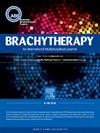用常规CT表进行电磁跟踪:电磁场畸变的量化与校正。
IF 1.7
4区 医学
Q4 ONCOLOGY
引用次数: 0
摘要
目的:量化传统计算机断层扫描(CT)表中金属元件产生的电磁场畸变对电磁(EM)跟踪精度的影响。提出了将准确性恢复到临床可接受水平的纠正方法。方法:采用常规GE和Siemens CT扫描仪对NDI Aurora EM跟踪系统的传感器位置和方向进行了EM跟踪精度评估。畸变效应被量化为传感器与电磁场发生器(EFG)的距离、上面的高度和沿CT台的纵向距离的函数。我们开发了一种基于地图的畸变校正方法,并利用间隙串联和卵形/环形涂抹器模型对其进行了评估。结果:常规CT桌面会产生EM畸变,导致临床上明显的定位错误。当传感器离CT工作台表面越近,离EFG越远,误差幅度越大。当传感器位置固定,但方向变化时,误差最大。结论:传统CT扫描台上的金属部件会产生EM畸变,导致非平行近距离治疗施药器几何形状(如串联、卵圆形或环形)的EM跟踪定位误差为0.5 mm。通过将电磁场发生器放置在离患者更近的地方,或者用护垫将患者抬高到手术台上方,可以减少电磁失真的影响。扭曲矫正可用于减少位置误差到临床可接受的水平。本文章由计算机程序翻译,如有差异,请以英文原文为准。
EM tracking with conventional CT tables: Quantifying and correcting for electromagnetic field distortion
PURPOSE
To quantify changes in electromagnetic (EM) tracking accuracy due to EM field distortion produced by metal components in conventional computed tomography (CT) tables. Correction methods are presented for restoring accuracy to clinically acceptable levels.
METHODS
EM tracking accuracy was evaluated as a function of sensor location and orientation for an NDI Aurora EM tracking system with conventional GE and Siemens CT scanners. Distortion effects were quantified as a function of sensor distance from the EM field generator (EFG) and height above and longitudinal distance along the CT table. A map-based distortion correction method was developed and evaluated using interstitial tandem and ovoid/ring applicator phantoms.
RESULTS
Conventional CT tabletops produced EM distortion that resulted in clinically significant localization errors. The error magnitude increased when the sensor was located closer to the CT table surface and further from the EFG. The greatest errors occurred when the sensor position was fixed, but the orientation was varied. Under typical brachytherapy conditions, errors due to sensor translation were <1 mm for translations of ±50 mm, while errors produced by orientation averaged (maximum) 3.5 (5.3) mm for DICOM YZ plane rotations and 2.0 (2.9) mm for DICOM XZ plane rotations. A clinical interstitial tandem and ovoid applicator set had median (min, max) distortion errors of 1.5 (1.3, 4.7) mm for applicator tips and 0.6 (0.0, 4.0) mm for shafts. Map-based distortion corrections reduced these errors to 0.6 (0.2, 1.7) mm and 0.4 (0.0, 1.8) mm.
CONCLUSION
The metal components in conventional CT scanner tables produce EM distortion that can result in EM tracking localization errors >5 mm for nonparallel brachytherapy applicator geometries such as the tandem and ovoid or ring. The effects of EM distortion may be reduced by placing the EM field generator closer to the patient or elevating the patient above the table with pads. Distortion corrections can be used to reduce position errors to clinically acceptable levels.
求助全文
通过发布文献求助,成功后即可免费获取论文全文。
去求助
来源期刊

Brachytherapy
医学-核医学
CiteScore
3.40
自引率
21.10%
发文量
119
审稿时长
9.1 weeks
期刊介绍:
Brachytherapy is an international and multidisciplinary journal that publishes original peer-reviewed articles and selected reviews on the techniques and clinical applications of interstitial and intracavitary radiation in the management of cancers. Laboratory and experimental research relevant to clinical practice is also included. Related disciplines include medical physics, medical oncology, and radiation oncology and radiology. Brachytherapy publishes technical advances, original articles, reviews, and point/counterpoint on controversial issues. Original articles that address any aspect of brachytherapy are invited. Letters to the Editor-in-Chief are encouraged.
 求助内容:
求助内容: 应助结果提醒方式:
应助结果提醒方式:


